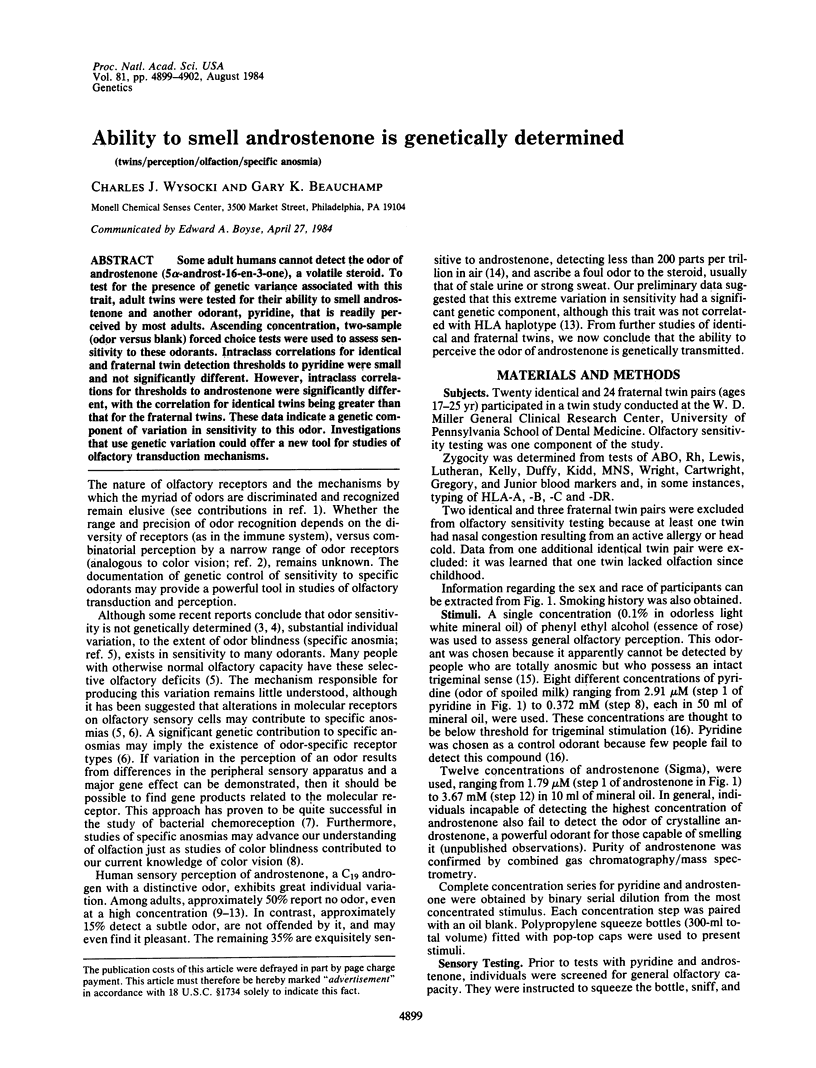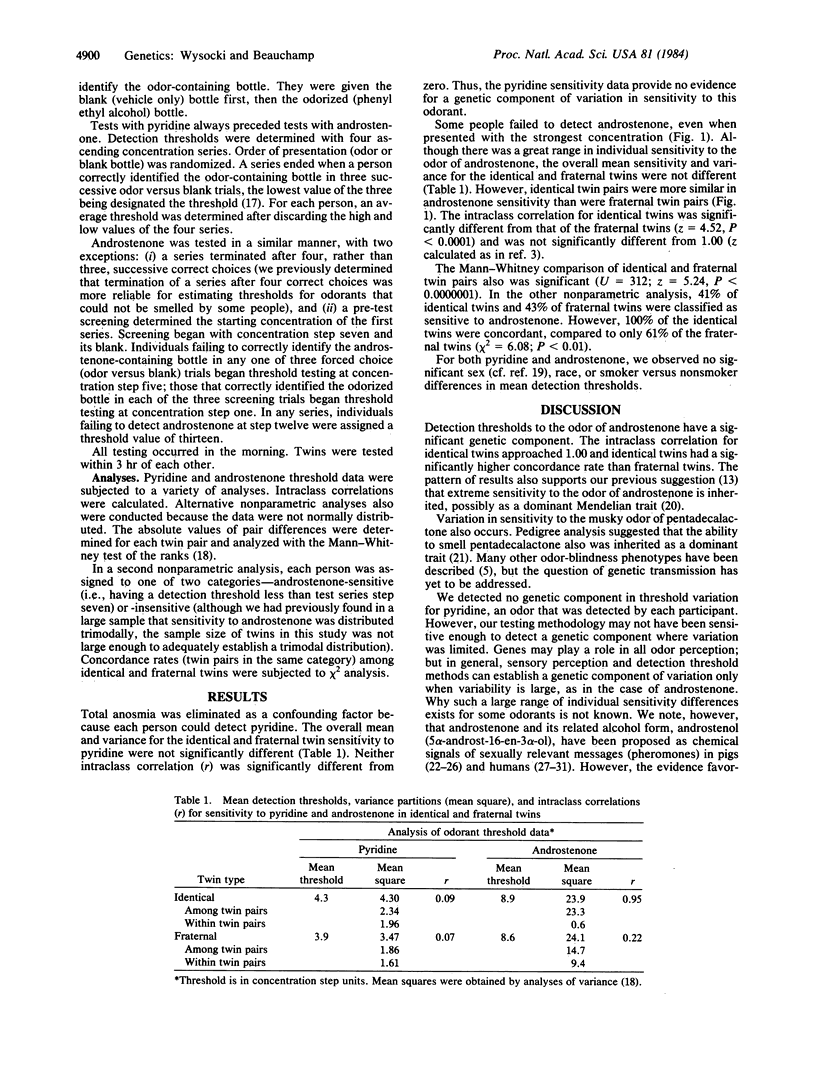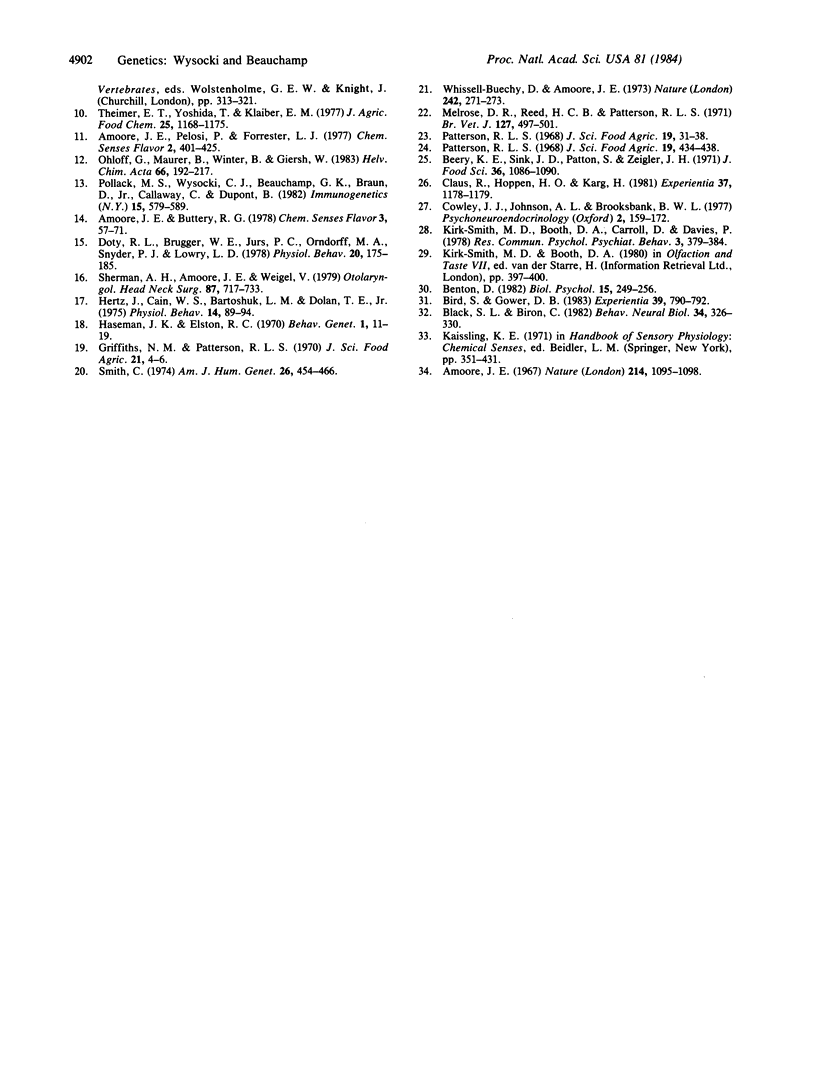Abstract
Some adult humans cannot detect the odor of androstenone (5 alpha-androst-16-en-3-one), a volatile steroid. To test for the presence of genetic variance associated with this trait, adult twins were tested for their ability to smell androstenone and another odorant, pyridine, that is readily perceived by most adults. Ascending concentration, two-sample (odor versus blank) forced choice tests were used to assess sensitivity to these odorants. Intraclass correlations for identical and fraternal twin detection thresholds to pyridine were small and not significantly different. However, intraclass correlations for thresholds to androstenone were significantly different, with the correlation for identical twins being greater than that for the fraternal twins. These data indicate a genetic component of variation in sensitivity to this odor. Investigations that use genetic variation could offer a new tool for studies of olfactory transduction mechanisms.
Full text
PDF



Selected References
These references are in PubMed. This may not be the complete list of references from this article.
- Amoore J. E. Specific anosmia: a clue to the olfactory code. Nature. 1967 Jun 10;214(5093):1095–1098. doi: 10.1038/2141095a0. [DOI] [PubMed] [Google Scholar]
- Benton D. The influence of androstenol - a putative human pheromone - on mood throughout the menstrual cycle. Biol Psychol. 1982 Nov-Dec;15(3-4):249–256. doi: 10.1016/0301-0511(82)90047-3. [DOI] [PubMed] [Google Scholar]
- Bird S., Gower D. B. Estimation of the odorous steroid, 5 alpha-androst-16-en-3-one, in human saliva. Experientia. 1983 Jul 15;39(7):790–792. doi: 10.1007/BF01990330. [DOI] [PubMed] [Google Scholar]
- Black S. L., Biron C. Androstenol as a human pheromone: no effect on perceived physical attractiveness. Behav Neural Biol. 1982 Mar;34(3):326–330. doi: 10.1016/s0163-1047(82)91711-3. [DOI] [PubMed] [Google Scholar]
- Cowley J. J., Johnson A. L., Brooksbank B. W. The effect of two odorous compounds on performance in an assessment-of-people test. Psychoneuroendocrinology. 1977;2(2):159–172. doi: 10.1016/0306-4530(77)90021-x. [DOI] [PubMed] [Google Scholar]
- Doty R. L., Brugger W. E., Jurs P. C., Orndorff M. A., Snyder P. J., Lowry L. D. Intranasal trigeminal stimulation from odorous volatiles: psychometric responses from anosmic and normal humans. Physiol Behav. 1978 Feb;20(2):175–185. doi: 10.1016/0031-9384(78)90070-7. [DOI] [PubMed] [Google Scholar]
- Griffiths N. M., Patterson R. L. Human olfactory responses to 5-alpha-androst-16-en-3-one--principal component of boar taint. J Sci Food Agric. 1970 Jan;21(1):4–6. doi: 10.1002/jsfa.2740210102. [DOI] [PubMed] [Google Scholar]
- Haseman J. K., Elston R. C. The estimation of genetic variance from twin data. Behav Genet. 1970 Feb;1(1):11–19. doi: 10.1007/BF01067367. [DOI] [PubMed] [Google Scholar]
- Hertz J., Cain W. S., Bartoshuk L. M., Dolan T. F., Jr Olfactory and taste sensitivity in children with cystic fibrosis. Physiol Behav. 1975 Jan;14(1):89–94. doi: 10.1016/0031-9384(75)90147-x. [DOI] [PubMed] [Google Scholar]
- Hubert H. B., Fabsitz R. R., Feinleib M., Brown K. S. Olfactory sensitivity in humans: genetic versus environmental control. Science. 1980 May 9;208(4444):607–609. doi: 10.1126/science.7189296. [DOI] [PubMed] [Google Scholar]
- Melrose D. R., Reed H. C., Patterson R. L. Androgen steroids associated with boar odour as an aid to the detection of oestrus in pig artificial insemination. Br Vet J. 1971 Oct;127(10):497–502. doi: 10.1016/s0007-1935(17)37337-2. [DOI] [PubMed] [Google Scholar]
- Persaud K., Dodd G. Analysis of discrimination mechanisms in the mammalian olfactory system using a model nose. Nature. 1982 Sep 23;299(5881):352–355. doi: 10.1038/299352a0. [DOI] [PubMed] [Google Scholar]
- Pollack M. S., Wysocki C. J., Beauchamp G. K., Braun D., Jr, Callaway C., Dupont B. Absence of HLA association or linkage for variations in sensitivity to the odor of androstenone. Immunogenetics. 1982;15(6):579–589. doi: 10.1007/BF00347052. [DOI] [PubMed] [Google Scholar]
- Russo A. F., Koshland D. E., Jr Separation of signal transduction and adaptation functions of the aspartate receptor in bacterial sensing. Science. 1983 Jun 3;220(4601):1016–1020. doi: 10.1126/science.6302843. [DOI] [PubMed] [Google Scholar]
- Sherman A. H., Amoore J. E., Weigel V. The pyridine scale for clinical measurement of olfactory threshold: a quantitative reevaluation. Otolaryngol Head Neck Surg (1979) 1979 Nov-Dec;87(6):717–733. doi: 10.1177/019459987908700604. [DOI] [PubMed] [Google Scholar]
- Smith C. Concordance in twins: methods and interpretation. Am J Hum Genet. 1974 Jul;26(4):454–466. [PMC free article] [PubMed] [Google Scholar]
- Theimer E. T., Yoshida T., Klaiber E. M. Olfaction and molecular shape. Chirality as a requisite for odor. J Agric Food Chem. 1977 Sep-Oct;25(5):1168–1177. doi: 10.1021/jf60213a029. [DOI] [PubMed] [Google Scholar]
- Whissell-Buechy D., Amoore J. E. Odour-blindness to musk: simple recessive inheritance. Nature. 1973 Mar 23;242(5395):271–273. doi: 10.1038/242271a0. [DOI] [PubMed] [Google Scholar]


